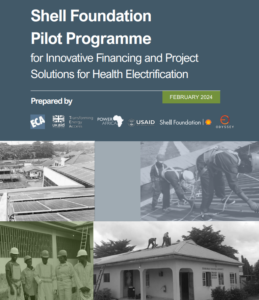Insights from a Pilot Programme for Healthcare Electrification in Sub-Saharan Africa
To address this challenge, Shell Foundation, the UK’s Foreign Commonwealth and Development Office through the Transforming Energy Access platform, Power Africa, and USAID, have funded a pilot programme that tests innovative solutions for deploying solar photovoltaic systems to power health facilities in a sustainable and scalable way.

Electrification has layered impact
The pilot programme, published in collaboration with Economic Consulting Associates and Odyssey Energy Solutions, has supported six renewable energy companies to electrify 11 health facilities in Nigeria, Ghana, Benin, and the Democratic Republic of Congo. These facilities range from small clinics to large hospitals, serving over 300,000 people. The electrification of these facilities has led to:
- Improved quality of care: The facilities have increased their operating hours, expanded their services, acquired new equipment, and improved their staff capacity.
- Increased patient satisfaction: The patients have reported higher satisfaction with the quality of care, the waiting time, and the cleanliness of the facilities.
- Reduced energy costs: The facilities have saved money on their electricity bills, as they rely less on diesel generators and grid connections.
- Enhanced environmental benefits: The facilities have reduced their greenhouse gas emissions and their dependence on fossil fuels.
Insights and learnings
The pilot programme has also generated valuable insights and learnings for the design and implementation of future healthcare electrification initiatives. By collecting and analysing data from the projects, the pilot programme has identified: 
- The key factors of success, the main challenges and risks, and the best practices and recommendations for each business model and financing mechanism used by the developers.
- The role of technology in facilitating the monitoring and evaluation of the projects, as well as informing future strategies, through Odyssey’s Powering Health Platform.
- The importance of context-specific strategies, efficient data management, and strong collaboration among stakeholders to optimise the electrification of healthcare facilities.
Significant investment and innovation to close the funding gap
The pilot programme has demonstrated that electrifying health facilities in sub-Saharan Africa is feasible and beneficial. However, it also requires significant investment and innovation. The total investment needed to close the electrification gap for health facilities in the region is estimated at USD 2.5 billion, which includes:
- USD 945 million for hospitals, mainly for installing off-grid systems that can meet their high energy demand and reliability requirements.
- USD 1,593 million for non-hospital facilities, mainly for connecting them to the grid or providing them with backup systems.
The need for ongoing financial support
While initial funding for the capital expenditure is typically covered by grants from donors (with Shell Foundation grants playing a key role in the pilot for reducing the costs to the developers and the health facilities), all developers stressed that sustaining the long-term functionality of these systems requires ongoing financial support for the operational expenditure. This can be achieved through various mechanisms, such as performance-based contracts, results-based financing, climate finance instruments, and guarantees.
The pilot programme has provided a valuable contribution to the healthcare electrification sector, by showcasing the potential of solar photovoltaic systems to power health facilities in sub-Saharan Africa, and by sharing the lessons learned from the implementation of different solutions. The Final Report offers an overview of the pilot programme, as well as recommendations for the sector when planning future initiatives.
















